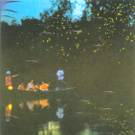|
Flight
of the Fireflies Thousands
of these fairy-like creatures light up the night in the small by
Michele C. Hollow As
the small wooden sampan gently glides down the river on this moonless
night, I look to the distance and see a flicker of light. As we get closer,
the lights grow brighter. It looks as if someone strung a handful of tiny
white Christmas tree lights on the trees along the Flickering
on and off, as we draw nearer, I can make out the trees that line
both sides of the river. The guide assures me that these tiny white
lights aren't Christmas tree lights. These are the famous fireflies
of Kampung Kuantan, which is about a ninety-minute drive northwest
of Kuala Lumpur in Malaysia. Deeper
along the route, the trees are illuminated by thousands of Kampung
Kuantan is one of the few places in the world where thousands of these
shining stars cluster together. Kampung, the Malaysian word for village,
is a small village surrounded by coconut and palm oil Here,
along the river away from the plantations, the fireflies illuminate Fireflies
twinkle every three seconds to attract mates. The lights, The
fireflies are not attracted to flashlights or flashbulbs on cameras. The
mangrove tree is a type of oak tree that grows abundantly on these The
fireflies only come out at night. During the day, they retreat to The
best conditions to view the fireflies are on moonless nights. This —Michele C. Hollow is a freelance writer living in New Jersey.
Copyright©EighthSquare.com P.O. Box 580, New York, NY 10113 |
|

